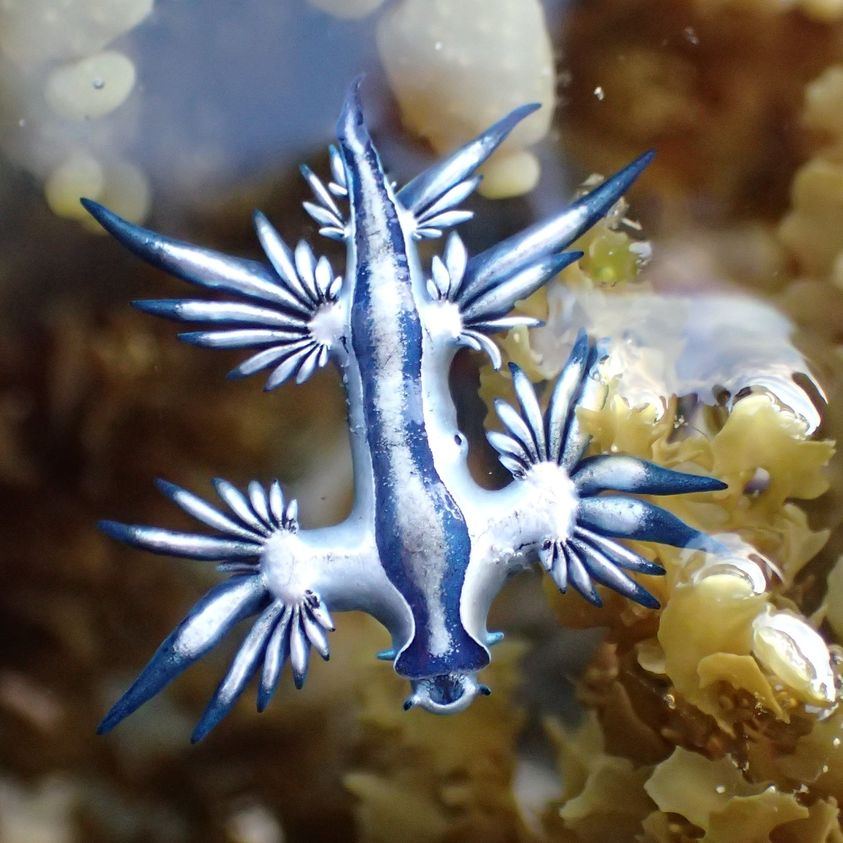Published on
August 21, 2025

Spain’s Costa Blanca, with its familiar sun-soaked coves that draw crowds each summer, has met with an unanticipated turn. A rare influx of dangerous marine life has prompted an emergency closure of a seven-mile oceanfront. The Guardamar del Segura strand, just beyond Torrevieja, now forbids any swimmer from entering its sapphire shallows, as passing blue dragons, delicate creatures of brilliant azure, yet laced with potent venom, drift uncommonly close to shore. Visitors, residents, and emergency services are united in cautious curiosity, sealing off strands and deploying warnings to safeguard each guest.
The Blue Dragon: A Beautiful Yet Deadly Sea Creature
The creature responsible for this disruption is the Glaucus atlanticus, more commonly known as the blue dragon. This strikingly beautiful, small sea slug is often called “the most beautiful killer in the ocean” because of its appearance and its dangerous nature. Measuring only around 1.5 inches in length, the blue dragon is easily recognisable by its brilliant blue and silver colour. It lives in warm, coastal waters, feeding on other venomous marine life, such as the notorious Portuguese man o’ war.
Why the Blue Dragon Is So Dangerous
The blue dragon, while appearing harmless and attractive, has earned a reputation for being highly venomous. It ingests the venomous cells of creatures like the Portuguese man o’ war, storing them within its body. This process concentrates the toxin, making the blue dragon’s sting far more potent than that of its prey. The sting of a blue dragon can cause intense pain, nausea, vomiting, and in some cases, severe allergic reactions. The threat of these creatures has forced local authorities to take preventive measures in order to safeguard both residents and tourists.
Local Authorities’ Response to the Threat
In response to the sudden appearance of these creatures, Guardamar del Segura Town Hall has launched a comprehensive operation to monitor the presence of blue dragons. The local government has been working closely with emergency services, lifeguards, and other authorities to track the spread of these creatures and to inform the public of the dangers they pose. As part of this operation, the beaches in the municipality have been placed under a strict bathing ban to prevent potential stings.
Lifeguards, armed with loudhailers, are patrolling the beaches to ensure that the ban is respected. Tourists are being reminded regularly about the dangers posed by the blue dragon and are advised not to enter the water under any circumstances. Although the beaches remain open for sunbathing, anyone found violating the no-swimming rule is at risk of heavy fines.
Beaches Remain Closed While Further Measures Are Considered
The initial panic caused by the presence of the blue dragons on the beaches has slowly turned into a coordinated effort by local authorities to minimise risks and provide guidance to the public. While swimming has been prohibited for now, local officials continue to monitor the situation, constantly assessing the presence of these dangerous sea creatures along the shoreline. The government has also issued clear instructions on what to do if a blue dragon is spotted or if someone is stung.
In the event of a sting, the affected area should be rinsed with saltwater, and individuals are advised to seek immediate medical attention at the nearest health centre or first aid point. While the creatures themselves are small, their stings can cause significant discomfort and health risks, so caution is essential.
Recent Blue Dragon Sightings and Their Impact
Earlier this month, another sighting of the blue dragon occurred further west at Santa Barbara beach in La Linea de la Concepcion, near Gibraltar. Authorities were alerted after an emergency call reporting blue dragon sightings, and six creatures were discovered along the shoreline. While the beach was closed temporarily, it was reopened the following day with a yellow warning flag instead of the red one. This quick reopening followed the removal of the creatures, signalling that authorities were confident that the area was safe again.
However, the situation at Costa Blanca remains tense, as tourists and locals alike are reminded of the potential risks. Despite these warnings, some visitors continued to swim in defiance of the ban, although fewer than usual entered the sea. This disregard for safety regulations could result in even stricter measures or penalties in the future.
What to Do if You Encounter a Blue Dragon
While the blue dragon may seem like a fascinating creature to observe from a distance, experts caution against getting too close. The venomous cells that it absorbs from its prey can be transferred to anyone who comes into contact with it. If you do spot a blue dragon, it’s essential to avoid touching it, even with gloves. Authorities encourage visitors to report sightings immediately to lifeguards or local authorities so that swift action can be taken.
To stay safe, always remember that beach conditions can change quickly due to ocean currents. The movement of blue dragons along the coast is unpredictable, and authorities are working diligently to ensure public awareness. By following local guidelines and staying informed about updates from the town hall, both residents and tourists can help prevent accidents.
A Cautionary Tale for Beachgoers
Costa Blanca, famous for its sunny beaches and lively tourism, is now dealing with an unexpected visitor: the venomous blue dragon. This colourful sea slug may look beautiful, but its sting isn’t. Its arrival is a sign that we must respect nature and stay alert. Tourists should always pay attention to safety signs and follow advice from local officials. By taking the right steps, everyone can still enjoy the gorgeous beaches safely. With a little care, Costa Blanca will keep shining for travellers from every corner of the globe.
[Image Source: Bureau of Ocean Energy Management]

